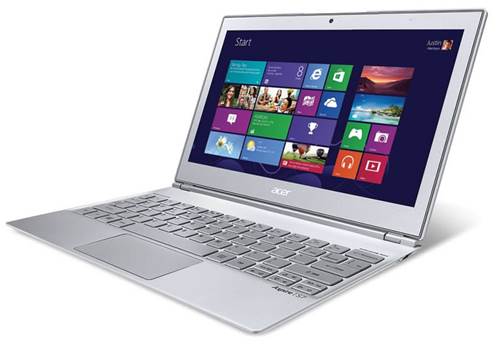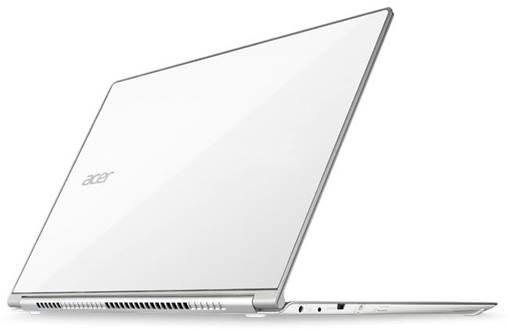Mark discovers the Acer S7 Series and
immediately wants one
I nearly didn’t review this equipment,
assuming at first that it was just a variant of the Acer Aspire S3-391. It
might have a similar code, but this is a very different computer from the S3,
and it's a dramatically more spectacular device.
The S7 series is a poster-boy for Windows
8, showing exactly what Microsoft was looking for when it imagined its target
hardware. Acer made it remarkably thin, light, powerful and stylish, just like
Microsoft wanted.

Acer
Aspire S7-391 Ultrabook
The review S7 system had a powerful Intel
Core i7 CPU, 256GB SSD, 4GB of DDR3 RAM and a stunning 1080p ten-point
touch-sensitive display. Yet, the whole system is just 11.9mm thick and weighs
a modest 1.3kg.
As if to highlight the narrow profile, Acer
provides a leather slim carry cover that looks like it should hold a dozen
sheets of paper. While this accessory is very elegant, the cover doesn't have
room for the power supply or mouse, so the minimalist sophistication lacks a
degree of practicality.
Another downside of it being so thin is
that Acer has cut a few corners to fit a powerful system inside the svelte
aluminum Ultrabook shell. There’s no optical drive, no easy upgrades, no LAN
port, and no VGA or DVI outputs.
In mitigation, Acer has included a USB 3.0
to Ethernet adapter, and a micro-HDMI port with cable to convert to full size
HDMI. There are only two USB ports, so using one for the LAN reduces you to
one, unless you have a USB 3.0 hub.

The
Aspire S7 is an ultraportable notebook driven by a low-voltage Intel Core
series processor
Windows 8 Pro comes pre-installed, as you
might expect, with the usual offer to add Microsoft Office if you open your
wallet wide enough. It's the 64-bit edition, even if the amount of RAM in the
computer isn't enough to justify using it over the 32-bit version of Windows 8.
After I'd stopped swooning at the amazing
viewing angles of the CineCrystal screen, the exceptional six-hour battery life
and the other wonderments, I started to use the S7 in earnest and found it
wasn't the faultless experience I'd hoped for.
The lack of better than Intel HD 4000 video
hardware in a system this expensive was marginally shocking, but the real
disappointment was the poor hardware/OS combination.
Curiously, while Windows 8 works well with
the touch screen, Acer also provided a touch-pad and a mouse. It wasn't long
before I worked out why it provided those: it's due to the high quality of the
display. A very high 1080p resolution panel makes Window icons and controls
remarkably small – at least a third the width of a typical fingertip. Because
of this you can use the touch interface until you enter an application, and
then you're forced to either deploy the mouse or touchpad.
This inconvenience is a Microsoft made one,
along with Metro apps that are difficult to dismiss, and that then slow the
system down. There's a general lack of coherent thinking that flows throughout
the entire user experience. When you have a keyboard, it's irritating to have
the touch keyboard occupy half the screen, although this regularly happens! This
can probably be configured away, but it's the default setting.

The
back of the lid is shiny-shiny white, looking like Aluminosilicate glass
Many of these usability issues are of
Microsoft's making, so I can't entirely blame Acer, but it's not a great experience
considering that this computer was built specifically to showcase Windows 8. As
I've seen similar complaints about Microsoft's Surface Pro, one can only
conclude the common component here is Windows 8.
However, not everything wrong can be blamed
on Windows 8; some tactical choices are patently Acer's mistakes. An obvious
one is that it chose not to allow the screen hinge to rotate back on the body
so that you could use the system as a pure tablet. Another is the grey
stenciled color on silver key tops, a combination that makes it difficult to
read them in almost all lighting conditions. The keyboard isn't great, though
I've yet to try an Ultrabook one that's half decent. The devil is in the
detail, and he's been very busy of late it seems.

However,
not everything wrong can be blamed on Windows 8; some tactical choices are
patently Acer's mistakes.
The last problem, as always with something
so beautifully made, is the price. You can get a Core i5 version for about
$1,500, but that is still a major chunk of change. For entirely personal
reasons, I wish it weren't so expensive, but wanting to pay less is probably
unrealistic considering what hardware Acer has packed in here.
I'd still love to own one, but clearly for
many reasons the S7 isn't the tour de force it should have been.
|
Details
§
Price: $1,800
§
Manufacturer: Acer
§
Ratings: 7/10
§
Model No: S7-391-73514G25aws
§
13.3” Multi-Touch FHD Acer CineCrystal LCD
§
Intel Core i7-3517U
§
256GB SSD
§
2in1 card reader
§
Acer Nplify 802.11a/g/n
§
Bluetooth 4.09
§
4-Cell Li-Polymer battery
§
Acer Crystal Eye HD webcam
§
2 x USB 3.0 slots
§ Windows
8
|